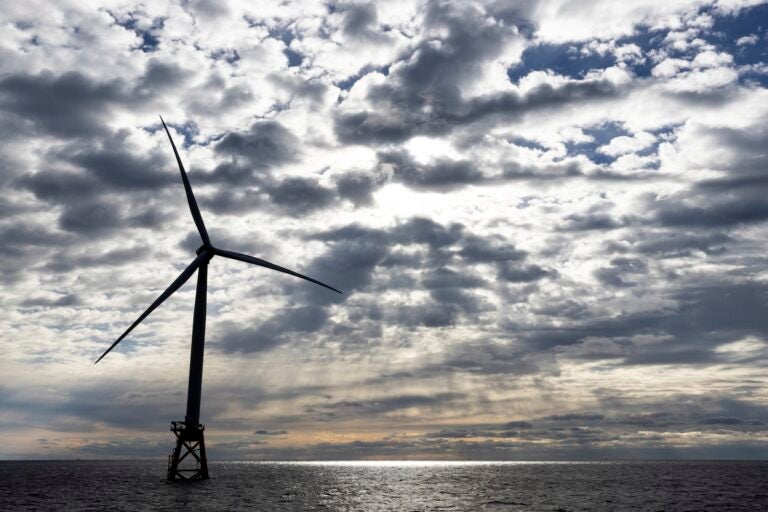Amidst market challenges for offshore wind, Delaware recommends flexibility for future state projects
Delaware report encourages the state to approach offshore wind with “flexibility” in an uncertain market.

A Block Island Wind Farm turbine operates, Dec. 7, 2023, off the coast of Block Island, R.I., during a tour of the South Fork Wind farm organized by Orsted. (AP Photo/Julia Nikhinson, File)
This story is part of the WHYY News Climate Desk, bringing you news and solutions for our changing region.
From the Poconos to the Jersey Shore to the mouth of the Delaware Bay, what do you want to know about climate change? What would you like us to cover? Get in touch.
Delaware’s environmental agency is recommending ways to develop offshore wind projects during a time of market uncertainty.
The offshore wind industry has taken a hit from inflation and supply chain issues. In November, offshore wind giant Ørsted canceled two projects off the coast of New Jersey, pointing to this, along with an agreement that locked in prices for its wind-generated electricity. Following similar issues, BP and Equinor canceled their contract to sell offshore wind energy to New York this week. The state is conducting a new bidding process. Still, there was some good news in the wind industry this week as Vineyard Wind, a 62-turbine wind farm off the coast of Massachusetts, turned on the switch to 800 megawatts of electricity.
Offshore wind is a major piece in President Biden’s push to decarbonize the grid, and reach the climate goal of 30 gigawatts of offshore wind energy by 2030 – enough to light up 10 million homes. Delaware’s push has a long history but has yet to get off the ground. Gov. Carney signed a bill last year to cut carbon dioxide and other greenhouse gas emissions by 50% by 2030 and reach a 100% net reduction by 2050.
A new 36-page report from Delaware’s Department of Natural Resources and Environmental Control recommends the state begin a legislative process to develop procurement policies for offshore wind in state waters. The agency urges the state to be flexible and consider fluid market conditions when procuring offshore wind projects.
“In reviewing these changing conditions, key factors, and anticipated developments coming up in 2024, the importance of flexibility cannot be overemphasized,” the report reads. “In developing and implementing an offshore wind procurement program, DNREC should not rely on what other states have done, but focus on what works best for Delaware.”
Dayna Cobb, director of DNREC’s Division of Climate, Coastal and Energy told WHYY News that flexibility will allow the state to “make sure that we minimize any potential risks, and best adapt to the changing industry conditions.”
“We’re looking at what’s happening now with our federal partners and how they have stepped in to help with supply chain issues,” she said. “We’re holistically looking at the landscape and how we can best move forward in a cost-effective way.”
The new report comes after Delaware lawmakers tasked DNREC with analyzing the costs and benefits of offshore wind in state waters.
The legislation codified research the agency has already begun, including data on economic and environmental benefits, associated costs of offshore wind development, and the state’s capability for offshore wind projects and their impacts on the electricity transmission system.
Among the recommendations, DNREC suggests the state consider partnering with neighboring states to expand its purchasing power, and take advantage of economies of scale regarding supply chains and new transmission lines.
The report also recommends the state research potential environmental or maritime impacts and take steps to mitigate any concerns.
DNREC said in the coming weeks, it will engage with various stakeholders and discuss the report’s findings.
State Sen. Stephanie Hansen, who sponsored the legislation calling for the report, called it a “deep and thoughtful” analysis. She said it’s important to consider mistakes that have been made in the past when hammering out procurement details.
“We have the benefit of hindsight, but we also have the benefit of the experience of our other regional states as to what they found in this process, how the industry has matured over the last few years, and where we think it’s going in the future,” Hansen said.
What’s next for Delaware?
Delaware is in better shape to hedge against market forces because the uncertainties are now clear, said Willett Kempton, a University of Delaware professor of marine science and policy who has studied offshore wind since 2006.
There are several steps Delaware must take before it successfully pursues an offshore wind project, Kempton said. The state must first draft and sign legislation to develop procurement policies that lay out the state’s top priorities when deciding among bids, he said. After the bill is passed, Kempton said the state must determine qualifications for bidders, and draft a request for bids.
One of the considerations may be whether the state will require bidders to create jobs, he said.
“Of course we’d like jobs and new industries that are high quality, high paying jobs. But if we just say, ‘Hey, you got to build a factory here,’ that’s going to up the cost of electricity,” Kempton said. “A maintenance port, for example, is a very good facility. It doesn’t add that much to the project cost, but it creates jobs over a 20- to 30-year period.”
Delaware must also determine how transmission access will be granted, and clearly define the process so beach communities can approve the project without hesitation, he said
“[The power lines] have to cross under the beach and under the land next to the beach. That’s not really an environmental problem, but it’s just something people worry about, and can take a long time for local communities to make decisions about,” Kempton said.
Ørsted’s plans in New Jersey ran up against strong local opposition, which led to lawsuits.
Willett also recommends the state utilize what’s known as a power purchase agreement, or PPA, for which the state directs the utility to provide a price per megawatt hour.
“It’s very straightforward,” he said. “Everybody can understand, ‘Cost of electricity is $50 a megawatt hour,’ and, ‘Is that more or less than what we’re paying now?’ It’s really clear.”

Get daily updates from WHYY News!
WHYY is your source for fact-based, in-depth journalism and information. As a nonprofit organization, we rely on financial support from readers like you. Please give today.






